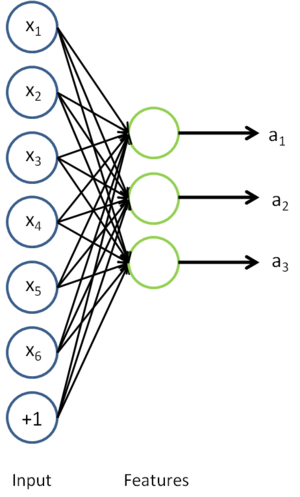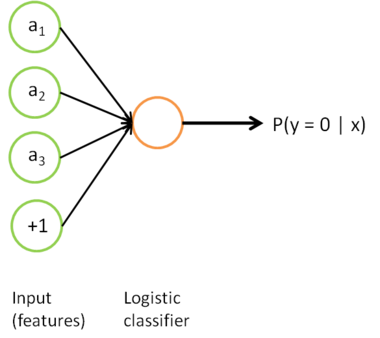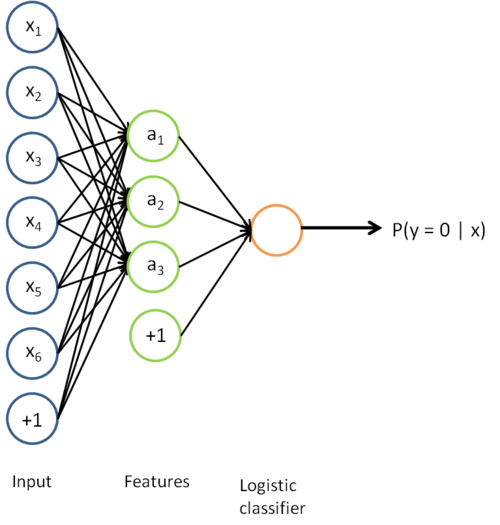Self-Taught Learning to Deep Networks
In this section, we describe how you can fine-tune and further improve the learned features using labeled data. When you have a large amount of labeled training data, this can significantly improve your classifier's performance.
In self-taught learning, we first trained a sparse autoencoder on the unlabeled data. Then, given a new example
, we used the hidden layer to extract features
. This is illustrated in the following diagram:
We are interested in solving a classification task, where our goal is to predict labels
. We have a labeled training set
of
labeled examples. We showed previously that we can replace the original features
with features
computed by the sparse autoencoder (the "replacement" representation). This gives us a training set
. Finally, we train a logistic classifier to map from the features
to the classification label
.
we can draw our logistic regression unit (shown in orange) as follows:
Now, consider the overall classifier (i.e., the input-output mapping) that we have learned using this method. In particular, let us examine the function that our classifier uses to map from from a new test example
to a new prediction p(y = 1 | x). We can draw a representation of this function by putting together the two pictures from above. In particular, the final classifier looks like this:
The parameters of this model were trained in two stages: The first layer of weights  mapping from the input
mapping from the input  to the hidden unit activations
to the hidden unit activations  were trained as part of the sparse autoencoder training process. The second layer of weights
were trained as part of the sparse autoencoder training process. The second layer of weights  mapping from the activations
mapping from the activations  to the output
to the output  was trained using logistic regression (or softmax regression).
was trained using logistic regression (or softmax regression).
But the form of our overall/final classifier is clearly just a whole big neural network. So, having trained up an initial set of parameters for our model (training the first layer using an autoencoder, and the second layer via logistic/softmax regression), we can further modify all the parameters in our model to try to further reduce the training error. In particular, we can fine-tune the parameters, meaning perform gradient descent (or use L-BFGS) from the current setting of the parameters to try to reduce the training error on our labeled training set  .
.
When fine-tuning is used, sometimes the original unsupervised feature learning steps (i.e., training the autoencoder and the logistic classifier) are called pre-training. The effect of fine-tuning is that the labeled data can be used to modify the weights W(1) as well, so that adjustments can be made to the features a extracted by the layer of hidden units.
if we are using fine-tuning usually we will do so with a network built using the replacement representation. (If you are not using fine-tuning however, then sometimes the concatenation representation can give much better performance.)
When should we use fine-tuning? It is typically used only if you have a large labeled training set; in this setting, fine-tuning can significantly improve the performance of your classifier. However, if you have a large unlabeled dataset (for unsupervised feature learning/pre-training) and only a relatively small labeled training set, then fine-tuning is significantly less likely to help.
Self-Taught Learning to Deep Networks的更多相关文章
- 【论文考古】联邦学习开山之作 Communication-Efficient Learning of Deep Networks from Decentralized Data
B. McMahan, E. Moore, D. Ramage, S. Hampson, and B. A. y Arcas, "Communication-Efficient Learni ...
- Communication-Efficient Learning of Deep Networks from Decentralized Data
郑重声明:原文参见标题,如有侵权,请联系作者,将会撤销发布! Proceedings of the 20th International Conference on Artificial Intell ...
- Deep Learning 8_深度学习UFLDL教程:Stacked Autocoders and Implement deep networks for digit classification_Exercise(斯坦福大学深度学习教程)
前言 1.理论知识:UFLDL教程.Deep learning:十六(deep networks) 2.实验环境:win7, matlab2015b,16G内存,2T硬盘 3.实验内容:Exercis ...
- (转)Understanding, generalisation, and transfer learning in deep neural networks
Understanding, generalisation, and transfer learning in deep neural networks FEBRUARY 27, 2017 Thi ...
- 论文笔记之:UNSUPERVISED REPRESENTATION LEARNING WITH DEEP CONVOLUTIONAL GENERATIVE ADVERSARIAL NETWORKS
UNSUPERVISED REPRESENTATION LEARNING WITH DEEP CONVOLUTIONAL GENERATIVE ADVERSARIAL NETWORKS ICLR 2 ...
- 深度学习材料:从感知机到深度网络A Deep Learning Tutorial: From Perceptrons to Deep Networks
In recent years, there’s been a resurgence in the field of Artificial Intelligence. It’s spread beyo ...
- This instability is a fundamental problem for gradient-based learning in deep neural networks. vanishing exploding gradient problem
The unstable gradient problem: The fundamental problem here isn't so much the vanishing gradient pro ...
- [译]深度神经网络的多任务学习概览(An Overview of Multi-task Learning in Deep Neural Networks)
译自:http://sebastianruder.com/multi-task/ 1. 前言 在机器学习中,我们通常关心优化某一特定指标,不管这个指标是一个标准值,还是企业KPI.为了达到这个目标,我 ...
- Learning Combinatorial Embedding Networks for Deep Graph Matching(基于图嵌入的深度图匹配)
1. 文献信息 题目: Learning Combinatorial Embedding Networks for Deep Graph Matching(基于图嵌入的深度图匹配) 作者:上海交通大学 ...
随机推荐
- PostgreSQL Replication之第四章 设置异步复制(7)
4.7 冲突管理 在PostgreSQL中,流复制数据仅在一个方向流动.XLOG由master提供给几个slave,这些slave消耗事务日志并为您提供一个较好的数据备份.您可能想知道这怎么会导致冲突 ...
- NodeJS学习笔记 (25)逐行读取-readline(ok)
模块概览 readline是个非常实用的模块.如名字所示,主要用来实现逐行读取,比如读取用户输入,或者读取文件内容.常见使用场景有下面几种,本文会逐一举例说明. 文件逐行读取:比如说进行日志分析. 自 ...
- [笔记-图论]Floyd
用于可带负权的多源最短路 时间复杂度O(n^3) 注意一定不要给Floyd一个带负环的图,不然就没有什么意义了(最短路不存在) 模板 // Floyd // to get minumum distan ...
- [笔记-图论]Dijkstra
用于求正权有向图 上的 单源最短路 优化后时间复杂度O(mlogn) 模板 // Dijkstra // to get the minumum distance with no negtive way ...
- win7 ssd评分降为5.9的诡异问题解决方法
某一天偶然发现win7的系统评分里面,磁盘一项由之前的7.9降到5.9了,SSD早听说会有降速的问题,但无论如何降,也不至于被降到5.9分这一机械硬盘普遍的分数. 百度搜了,Google搜了,中文搜了 ...
- 【转】CentOS下firefox安装flash说明
http://www.cnblogs.com/lamper/archive/2013/01/16/2862254.htm CentOS下自带了firefox,但没有flash插件的,按它自己的提示安装 ...
- Android Studio更改项目SDK的版本
Elipse 中的安卓项目,在Android Studio中可以通过File -->new -- > Import Project的方法建立起来.但是有时候需要用到更改项目的API Lev ...
- Java 实现状态(State)模式
/** * @author stone */ public class WindowState { private String stateValue; public WindowState(Stri ...
- Using a Plugin
创建hello.world <?xml version="1.0"?> <sdf version="1.4"> <world na ...
- modSecurity规则学习(八)——防止CC攻击
modSecurity日志收集:在phase 5阶段处理. 由于CC攻击主要考虑对动态请求的防护,所以要排除静态资源的请求,或者自定义动态请求的后缀或者关键字做接口针对性的防护. 定义需要排除的请求u ...



